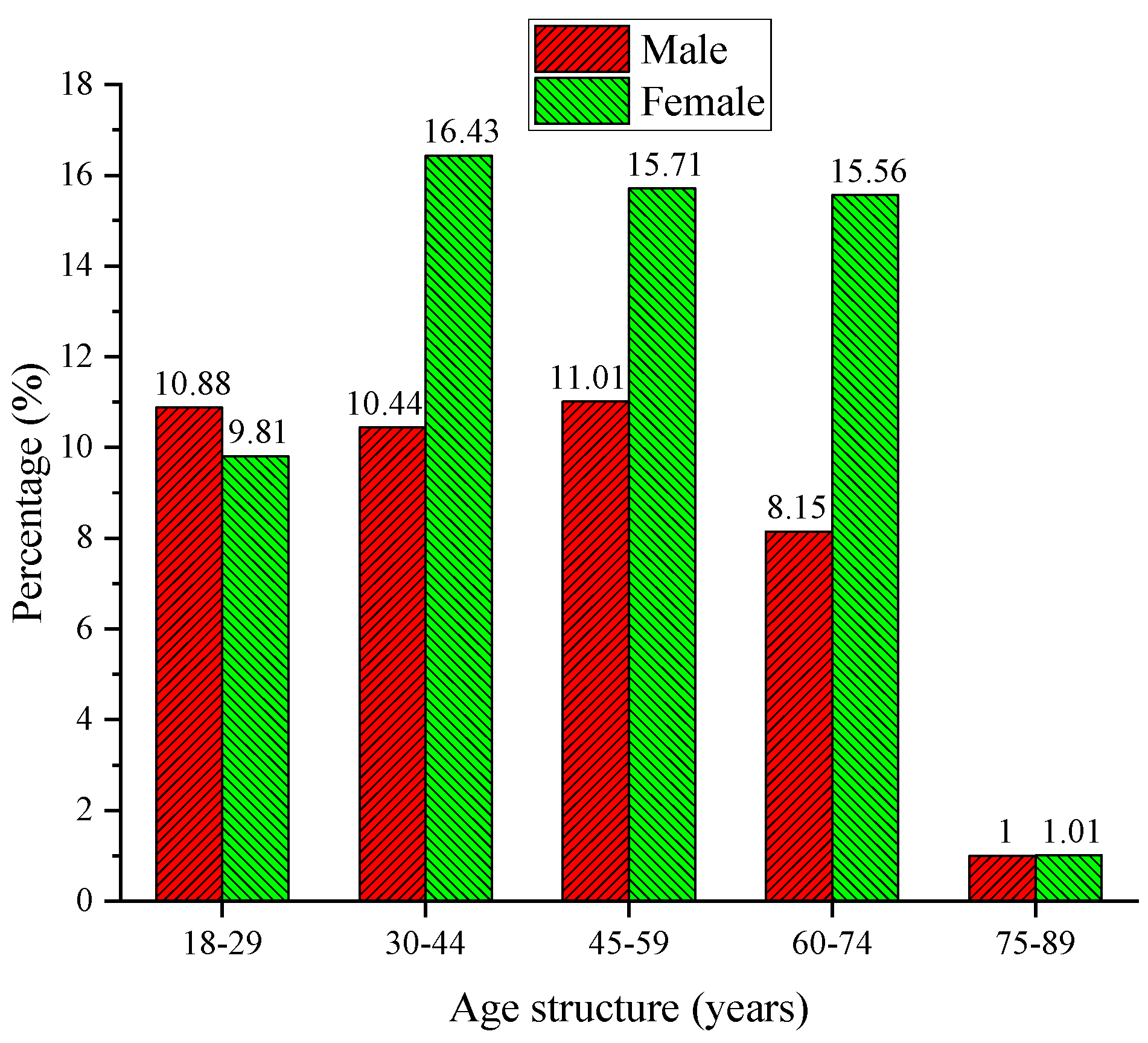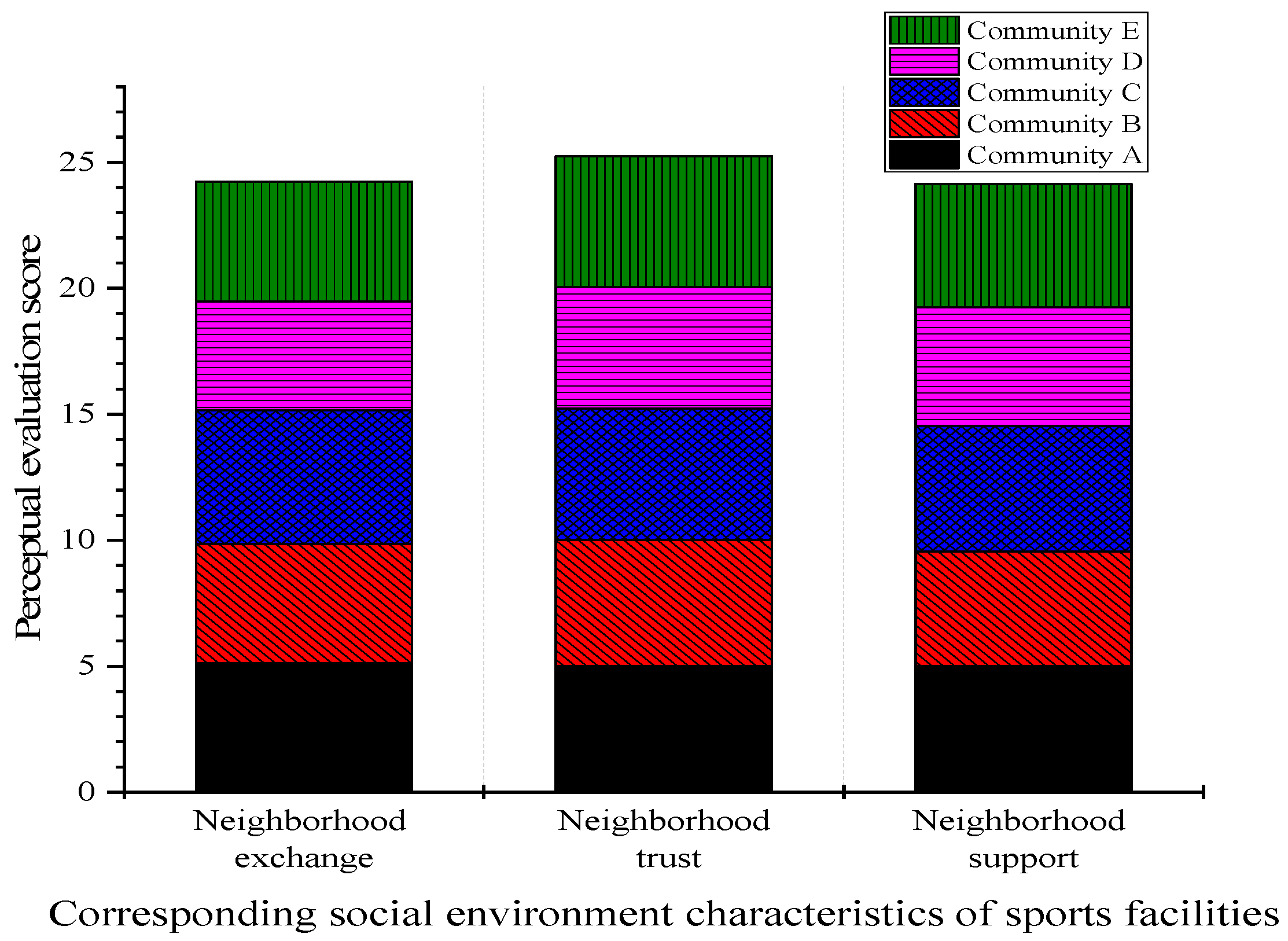Influence of Public Sports Services on Residents’ Mental Health at Communities Level: New Insights from China
Abstract
:1. Introduction
2. Theoretical Framework
3. Methodology
3.1. Data Sources
3.2. Empirical Estimation
4. Results and Discussion
4.1. Respondents’ Summary Characteristics
4.2. Current Status of Public Services in the Study Area
4.3. Mental Health Characteristics
4.4. Differences in the Mental Health Status Based on Resident Characteristics
4.5. Multi-Level Multiple Linear Regression Results
4.6. Mediation Analysis Results
4.7. Discussions
5. Conclusions and Policy Recommendations
Author Contributions
Funding
Institutional Review Board Statement
Informed Consent Statement
Data Availability Statement
Conflicts of Interest
References
- Kumar, N.M.; Chopra, S.S.; Chand, A.A.; Elavarasan, R.M.; Shafiullah, G.M. Hybrid renewable energy microgrid for a residential community: A techno-economic and environmental perspective in the context of the SDG7. Sustainability 2020, 12, 3944. [Google Scholar] [CrossRef]
- Byambasuren, O.; Cardona, M.; Bell, K.; Clark, J.; McLaws, M.-L.; Glasziou, P. Estimating the extent of asymptomatic COVID-19 and its potential for community transmission: Systematic review and meta-analysis. Off. J. Assoc. Med. Microbiol. Infect. Dis. Can. 2020, 5, 223–234. [Google Scholar]
- Ghenai, C.; Salameh, T.; Merabet, A. Technico-economic analysis of off grid solar PV/Fuel cell energy system for residential community in desert region. Int. J. Hydrogen Energy 2020, 45, 11460–11470. [Google Scholar] [CrossRef]
- Talapur, G.G.; Suryawanshi, H.M.; Xu, L.; Shitole, A.B. A reliable microgrid with seamless transition between grid connected and islanded mode for residential community with enhanced power quality. IEEE Trans. Ind. Appl. 2018, 54, 5246–5255. [Google Scholar] [CrossRef] [Green Version]
- Wang, D.; Qiao, C.; Liu, S.; Wang, C.; Yang, J.; Li, Y.; Huang, P. Assessment of spatial accessibility to residential care facilities in 2020 in Guangzhou by small-scale residential community data. Sustainability 2020, 12, 3169. [Google Scholar] [CrossRef] [Green Version]
- Chen, Q.; Liu, T. The effectiveness of community sports provision on social inclusion and public health in rural China. Int. J. Environ. Res. Public Health 2020, 17, 597. [Google Scholar] [CrossRef] [Green Version]
- Kim, J.; Kim, J.; Han, A. Leisure time physical activity mediates the relationship between neighborhood social cohesion and mental health among older adults. J. Appl. Gerontol. 2020, 39, 292–300. [Google Scholar] [CrossRef]
- Dixon, K.; Belshaw, D.; Johnson, P.; Flynn, D. Using football cultures as a vehicle to improve mental health in men: The case of the Redcar and cleveland boot room. Sport Soc. 2019, 22, 1258–1274. [Google Scholar] [CrossRef]
- Moreno, C.; Wykes, T.; Galderisi, S.; Nordentoft, M.; Crossley, N.; Jones, N.; Cannon, M.; Correll, C.U.; Byrne, L.; Carr, S.; et al. How mental health care should change as a consequence of the COVID-19 pandemic. Lancet Psychiatry 2020, 7, 813–824. [Google Scholar] [CrossRef]
- Kahane, G.; Everett, J.A.C.; Earp, B.D.; Caviola, L.; Faber, N.S.; Crockett, M.J.; Savulescu, J. Beyond sacrificial harm: A two-dimensional model of utilitarian psychology. Psychol. Rev. 2018, 125, 131. [Google Scholar] [CrossRef]
- Graham, S.; Depp, C.; Lee, E.E.; Nebeker, C.; Tu, X.; Kim, H.-C.; Jeste, D.V. Artificial intelligence for mental health and mental illnesses: An overview. Curr. Psychiatry Rep. 2020, 21, 116. [Google Scholar] [CrossRef] [PubMed]
- Borsboom, D.; van der Maas, H.L.J.; Dalege, J.; Kievit, R.A.; Haig, B.D. Theory construction methodology: A practical framework for building theories in psychology. Perspect. Psychol. Sci. 2021, 16, 756–766. [Google Scholar] [CrossRef]
- Liu, J.J.; Bao, Y.; Huang, X.; Shi, J.; Lu, L. Mental health considerations for children quarantined because of COVID-19. Lancet Child Adolesc. Health 2020, 4, 347–349. [Google Scholar] [CrossRef] [Green Version]
- Reffi, A.N.; Pinciotti, C.M.; Orcutt, H.K. Psychometric properties of the Institutional Betrayal Questionnaire, Version 2: Evidence for a two-factor model. J. Interpers. Violence 2021, 36, 5659–5684. [Google Scholar] [CrossRef] [PubMed]
- He, Q.; Li, J.J. Factorial invariance in hierarchical factor models of mental disorders in African American and European American youths. J. Child Psychol. Psychiatry 2021, 62, 289–298. [Google Scholar] [CrossRef] [PubMed] [Green Version]
- Campion, J.; Javed, A.; Sartorius, N.; Marmot, M. Addressing the public mental health challenge of COVID-19. Lancet Psychiatry 2020, 7, 657–659. [Google Scholar] [CrossRef] [PubMed]
- Howell, J.; Anderson, R.; Egan, S.; McEvoy, P. One factor? Two factor? Bi-factor? A psychometric evaluation of the Frost Multidimensional Scale and the Clinical Perfectionism Questionnaire. Cogn. Behav. Ther. 2020, 49, 518–530. [Google Scholar] [CrossRef]
- Holmberg, C.; Caro, J.; Sobis, I. Job satisfaction among Swedish mental health nursing personnel: Revisiting the two-factor theory. Int. J. Ment. Health Nurs. 2018, 27, 581–592. [Google Scholar] [CrossRef]
- Lamborn, P.; Cramer, K.M.; Riberdy, A. The structural validity and measurement invariance of the mental health continuum–short form (MHC-SF) in a large Canadian sample. J. Well-Being Assess. 2018, 2, 1–19. [Google Scholar] [CrossRef]
- Li, D.; Huang, F.; Yan, L.; Cao, Z.; Chen, J.; Ye, Z. Landslide susceptibility prediction using particle-swarm-optimized multilayer perceptron: Comparisons with multilayer-perceptron-only, bp neural network, and information value models. Appl. Sci. 2019, 9, 3664. [Google Scholar] [CrossRef] [Green Version]
- Dudek, G. Multilayer perceptron for short-term load forecasting: From global to local approach. Neural Comput. Appl. 2020, 32, 3695–3707. [Google Scholar] [CrossRef]
- Ehteram, M.; Salih, S.Q.; Yaseen, Z.M. Efficiency evaluation of reverse osmosis desalination plant using hybridized multilayer perceptron with particle swarm optimization. Environ. Sci. Pollut. Res. 2020, 27, 15278–15291. [Google Scholar] [CrossRef] [PubMed]
- Zhang, Q.; Yu, H.; Barbiero, M.; Wang, B.; Gu, M. Artificial neural networks enabled by nanophotonics. Light Sci. Appl. 2019, 8, 42. [Google Scholar] [CrossRef] [PubMed] [Green Version]
- Gbemavo, C.J.D.S. Mathematical prediction of the Jatropha curcas L. plant yield: Comparing Multiple Linear Regression and Artificial Neural Network Multilayer Perceptron models. Afr. J. Appl. Stat. 2020, 7, 933–943. [Google Scholar] [CrossRef]
- Zador, A.M. A critique of pure learning and what artificial neural networks can learn from animal brains. Nat. Commun. 2019, 10, 3770. [Google Scholar] [CrossRef] [Green Version]
- Moon, J.; Kim, Y.; Son, M.; Hwang, E. Hybrid short-term load forecasting scheme using random forest and multilayer perceptron. Energies 2018, 11, 3283. [Google Scholar] [CrossRef] [Green Version]
- Lin, T.-L.; Tseng, H.-W.; Wen, Y.; Lai, F.-W.; Lin, C.-H.; Wang, C.-J. Reconstruction algorithm for lost frame of multiview videos in wireless multimedia sensor network based on deep learning multilayer perceptron regression. IEEE Sens. J. 2018, 18, 9792–9801. [Google Scholar] [CrossRef]
- Sanchez, D.; Adams, W.N.; Arango, S.C.; Flannigan, A.E. Racial-ethnic microaggressions, coping strategies, and mental health in Asian American and Latinx American college students: A mediation model. J. Couns. Psychol. 2018, 65, 214. [Google Scholar] [CrossRef]
- Wang, C.; Chudzicka-Czupała, A.; Tee, M.L.; Núñez, M.I.L.; Tripp, C.; Fardin, M.A.; Habib, H.A.; Tran, B.X.; Adamus, K.; Anlacan, J.; et al. A chain mediation model on COVID-19 symptoms and mental health outcomes in Americans, Asians and Europeans. Sci. Rep. 2021, 11, 6481. [Google Scholar] [CrossRef]
- Scandurra, C.; Bochicchio, V.; Amodeo, A.L.; Esposito, C.; Valerio, P.; Maldonato, N.M.; Bacchini, D.; Vitelli, R. Internalized transphobia, resilience, and mental health: Applying the Psychological Mediation Framework to Italian transgender individuals. Int. J. Environ. Res. Public Health 2018, 15, 508. [Google Scholar] [CrossRef] [Green Version]
- Arslan, G.; Yıldırım, M. Coronavirus stress, meaningful living, optimism, and depressive symptoms: A study of moderated mediation model. Aust. J. Psychol. 2021, 73, 113–124. [Google Scholar] [CrossRef]
- Battles, A.R.; Bravo, A.J.; Kelley, M.L.; White, T.D.; Braitman, A.L.; Hamrick, H.C. Moral injury and PTSD as mediators of the associations between morally injurious experiences and mental health and substance use. Traumatology 2018, 24, 246. [Google Scholar] [CrossRef]
- Gilal, F.G.; Ashraf, Z.; Gilal, R.G.; Chaana, N.A. Promoting environmental performance through green human resource management practices in higher education institutions: A moderated mediation model. Corp. Soc. Responsib. Environ. Manag. 2019, 26, 1579–1590. [Google Scholar] [CrossRef]
- Wang, Y.; Wang, X.; Liu, H.; Xie, X.; Wang, P.; Lei, L. Selfie posting and self-esteem among young adult women: A mediation model of positive feedback and body satisfaction. J. Health Psychol. 2020, 25, 161–172. [Google Scholar] [CrossRef] [PubMed]
- Feinstein, B.A. The rejection sensitivity model as a framework for understanding sexual minority mental health. Arch. Sex. Behav. 2020, 49, 2247–2258. [Google Scholar] [CrossRef] [PubMed]
- Gil de Zúñiga, H.; Diehl, T.; Huber, B.; Liu, J.H. The citizen communication mediation model across countries: A multilevel mediation model of news use and discussion on political participation. J. Commun. 2019, 69, 144–167. [Google Scholar] [CrossRef]
- Maan, A.T.; Abid, G.; Butt, T.H.; Ashfaq, F.; Ahmed, S. Perceived organizational support and job satisfaction: A moderated mediation model of proactive personality and psychological empowerment. Future Bus. J. 2020, 6, 21. [Google Scholar] [CrossRef]
- Wang, H.; Li, T.; Gauthier, S.; Yu, E.; Tang, Y.; Barbarino, P.; Yu, X. Coronavirus epidemic and geriatric mental healthcare in China: How a coordinated response by professional organizations helped older adults during an unprecedented crisis. Int. Psychogeriatr. 2020, 32, 1117–1120. [Google Scholar] [CrossRef] [Green Version]
- Hirsch, J.K.; Smalley, K.B.; Selby-Nelson, E.M.; Hamel-Lambert, J.M.; Rosmann, M.R.; Barnes, T.A.; Abrahamson, D.; Meit, S.S.; GreyWolf, I.; Beckmann, S.; et al. Psychosocial impact of fracking: A review of the literature on the mental health consequences of hydraulic fracturing. Int. J. Ment. Health Addict. 2018, 16, 1–15. [Google Scholar] [CrossRef]
- Aziz, N.; Liu, T.; Yang, S.; Zukiewicz-Sobczak, W. Casual relationship between health insurance and overall health status of children: Insights from Pakistan. Front. Public Health. 2022, 10, 934007. [Google Scholar] [CrossRef] [PubMed]
- Aziz, N.; Jun, H.; Raza, A.; Sui, H. A systematic review of review studies on women’s empowerment and food security literature. Glob. FoodSecur. 2022, 34, 100647. [Google Scholar] [CrossRef]








| Community Public Sports Facilities | General Fitness Facility | Basketball Court | Table Tennis Court | Badminton Court | Indoor Gym | Other Fitness Facilities |
|---|---|---|---|---|---|---|
| Number of communities with facilities | 5 | 4 | 3 | 4 | 2 | 4 |
| Percentage of communities with facilities (%) | 100 | 80 | 60 | 80 | 40 | 80 |
| The Scale of Community Organization Activities | Less than 50 People | 50–100 People | 100–150 People | 150–200 People | More than 200 People |
|---|---|---|---|---|---|
| Community A | 10 | 6 | 3 | 4 | 2 |
| Community B | 8 | 5 | 5 | 5 | 1 |
| Community C | 11 | 5 | 6 | 3 | 0 |
| Community D | 7 | 8 | 6 | 3 | 2 |
| Community E | 9 | 6 | 7 | 4 | 3 |
Disclaimer/Publisher’s Note: The statements, opinions and data contained in all publications are solely those of the individual author(s) and contributor(s) and not of MDPI and/or the editor(s). MDPI and/or the editor(s) disclaim responsibility for any injury to people or property resulting from any ideas, methods, instructions or products referred to in the content. |
© 2023 by the authors. Licensee MDPI, Basel, Switzerland. This article is an open access article distributed under the terms and conditions of the Creative Commons Attribution (CC BY) license (https://creativecommons.org/licenses/by/4.0/).
Share and Cite
Lu, L.; Wei, W. Influence of Public Sports Services on Residents’ Mental Health at Communities Level: New Insights from China. Int. J. Environ. Res. Public Health 2023, 20, 1143. https://doi.org/10.3390/ijerph20021143
Lu L, Wei W. Influence of Public Sports Services on Residents’ Mental Health at Communities Level: New Insights from China. International Journal of Environmental Research and Public Health. 2023; 20(2):1143. https://doi.org/10.3390/ijerph20021143
Chicago/Turabian StyleLu, Liu, and Wei Wei. 2023. "Influence of Public Sports Services on Residents’ Mental Health at Communities Level: New Insights from China" International Journal of Environmental Research and Public Health 20, no. 2: 1143. https://doi.org/10.3390/ijerph20021143





